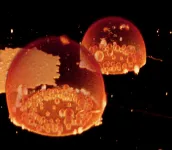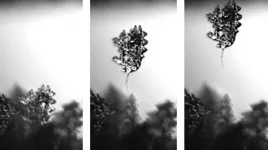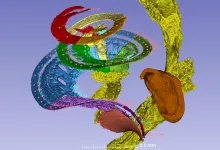(Press-News.org) To come into being, galaxies need a steady diet of cold gases to undergo gravitational collapse. The larger the galaxy, the more cold gas it needs to coalesce and to grow.
Massive galaxies found in the early universe needed a lot of cold gas--a store totaling as much as 100 billion times the mass of our sun.
But where did these early, super-sized galaxies get that much cold gas when they were hemmed in by hotter surroundings?
In a new study, astronomers led by the University of Iowa report direct, observational evidence of streams of cold gas they believe provisioned these early, massive galaxies. They detected cold gas pipelines that knifed through the hot atmosphere in the dark matter halo of an early massive galaxy, supplying the materials for the galaxy to form stars.
About two decades ago, physicists working with simulations theorized that during the early universe, cosmic filaments ferried cold gas and embryonic, node-shaped galaxies to a dark matter halo, where it all clumped together to form massive galaxies. The theory assumed the filaments would need to be narrow and densely filled with cold gas to avoid being peeled off by the hotter surrounding atmosphere.
But the theory lacked direct evidence. In this study, scientists studied a gaseous region surrounding a massive galaxy formed when the universe was about 2.5 billion years old, or just 20% of its present age. The galaxy was previously unstudied, and it took the team five years to pinpoint its exact location and distance (through its redshift). The team needed a specially equipped observatory, the Atacama Large Millimeter/Submillimeter Array, because the target galaxy's environment is so dusty that it can only be seen in the submillimeter range of the electromagnetic spectrum.
"It is the prototype, the first case where we detected a halo-scale stream that is feeding a very massive galaxy," says Hai Fu, associate professor in Iowa's Department of Physics and Astronomy and the study's lead and corresponding author. "Based on our observations, such streams can fill up the reservoir in about a billion years, which is far shorter than the amount of time that was available to the galaxy at the epoch that we were observing."
Crucially, the researchers located two background quasars that are projected at close angular distances to the target galaxy, much like how Jupiter and Saturn's motion drew them closer to each other when viewed from Earth during the Great Conjunction last December. Due to this unique configuration, the quasars' light penetrating the halo gas of the foreground galaxy left chemical "fingerprints" that confirmed the existence of a narrow stream of cold gas.
Those chemical fingerprints showed the gas in the streams had a low concentration of heavy elements such as aluminum, carbon, iron, and magnesium. Since these elements are formed when the star is still shining and are released into the surrounding medium when the star dies, the researchers determined the cold gas streams must be streaming in from outside, rather than being expelled from the star-making galaxy itself.
"Among the 70,000 starburst galaxies in our survey, this is the only one associated with two quasars that are both nearby enough to probe the halo gas. Even more, both quasars are projected on the same side of the galaxy so that their light can be blocked by the same stream at two different angular distances." Fu says. "So, I feel extremely fortunate that nature
provided us this opportunity to detect this major artery leading to the heart of a phenomenal galaxy during its adolescence."
INFORMATION:
The study, "A long stream of metal-poor cool gas around a massive starburst galaxy at Z=2.67," was published online in the Astrophysical Journal Feb. 24.
Study co-authors include Rui Xue, who was a postdoctoral researcher at Iowa and is now a software engineer at the National Radio Astronomical Observatory; Jason Prochaska from the University of California, Santa Cruz; Alan Stockton from the University of Hawaii-Honolulu; Sam Ponnada, who graduated from Iowa last May and is a graduate student at the California Institute of Technology; Marie Wingyee Lau, from the University of California, Riverside; Asantha Cooray, from the University of California, Irvine; and Desika Narayanan, from the University of Florida.
The U.S. National Science Foundation funded the research.
New research by the University of Oslo provides evidence that the "protocells" that formed around 3.8 billion years ago, before bacteria and single-celled organisms, could have had specialized bubble-like compartments that formed spontaneously, encapsulated small molecules, and formed "daughter" protocells.
ROCKVILLE, MD - Scientists have long speculated about the features that our long-ago single-celled ancestors might have had, and the order in which those features came about. Bubble-like compartments are a hallmark of the superkingdom to which we, and many other species including yeast, belong. But the cells in today's superkingdom have a host of specialized molecules that help make and shape these bubbles inside our ...
ATLANTA - FEBRUARY 24, 2021 - New study reports that early in the 2020 pandemic in the United States, one-third of cancer survivors worried about treatment and cancer care disruptions. Using a mixed methods approach, investigators utilized survivors' own words to more deeply describe their experiences and worries about the pandemic's impact on their overall health.
The article, appearing in the Journal of Psychosocial Oncology, finds the impact of the pandemic on cancer survivors and the broader health care system is widespread and exacerbated serious gaps in the health care system. For this study, investigators led by Corinne Leach, MPH, MS, PhD, from the American ...
If you have ever gotten up on a winter morning and thrown yourself into the arduous task of scraping frost from a windshield, a Virginia Tech lab is engaging science [IS1] that could make your life much easier. In research funded by the National Science Foundation, Associate Professor END ...
DALLAS, Feb. 24, 2021 -- Postmenopausal women who ate high levels of plant protein had lower risks of premature death, cardiovascular disease and dementia-related death compared with women who ate less plant proteins, according to new research published today in the Journal of the American Heart Association, an open access journal of the American Heart Association.
Previous research has shown an association between diets high in red meat and cardiovascular disease risk, yet the data is sparse and inconclusive about specific types of proteins, the study authors ...
In the largest genome-wide association study of glaucoma comparing the genes of 34,179 people with the disease to 349,321 control subjects, an international consortium of researchers identified 44 new gene loci and confirmed 83 previously reported loci linked to glaucoma. Loci are considered "genetic street addresses," denoting a specific location on a gene.
The study's authors hope the identification of these genes will lead to new treatment targets for this incurable eye disease that is a leading cause of blindness worldwide.
"These new findings come out of the highest-powered genome-wide association study of glaucoma to date, and show the power of team science and using big data to answer questions when research groups around the world join forces," said co-senior study author ...
Peer review/Experimental study/Cells
Researchers at Uppsala University have created the first 3D map of the hearing nerve showing where the various sound frequencies are captured. Using what is known as synchrotron X-ray imaging, they were able to trace the fine nerve threads and the vibrating auditory organ, the cochlea, and find out exactly how the frequencies of incoming sound are distributed. The study is published in Scientific Reports.
"This can make treatment with cochlea implants for the hearing-impaired more effective," says Helge Rask-Andersen, Professor of Experimental Otology at Uppsala ...
Genome variation data on more than 7,000 malaria parasites from 28 endemic countries is released today (24 February) in Wellcome Open Research. It has been produced by MalariaGEN, a data-sharing network of groups around the world who are working together to build high-quality data resources for malaria research and disease control.
This open data release represents the world's largest resource of genomic data on malaria parasite evolution and drug resistance. It provides benchmark data on parasite genome variation that is needed in the search for new drugs and vaccines, and in the development of surveillance tools for malaria control and elimination.
Malaria is a major global ...
In the journal Nature Communications, scientists of the German Center for Neurodegenerative Diseases (DZNE) report new findings on the mechanisms of "Niemann-Pick type C disease" (NPC). This rare brain disorder mainly manifests in childhood and includes severe neurological and psychiatric symptoms. Researchers led by Dr. Sabina Tahirovic have now found evidence that already at an early stage, NPC is associated with neuroinflammation and that this condition is triggered by impaired intracellular lipid transport. In addition, they identified pathological features in the blood of affected individuals that in the future could assist to better monitor the course of the disease and response to therapy.
NPC is a hereditary metabolic disorder ...
New research has found one in five people in the south London live with multimorbidity.
The study, published today in the Lancet Regional Health by researchers from King's College London and the NIHR Guy's and St Thomas' Biomedical Research Centre and supported by Impact on Urban Health, examined the prevalence of multimorbidity - two or more long-term diseases at once - and identified key relationships between diseases.
Researchers analysed electronic health records from participants aged 18 and over between April 2005 and May 2020 in one London borough. The borough has a deprived, ...
PHILADELPHIA - A machine learning-based tool was able to predict the risk of malignancy among patients presenting with multiple pulmonary nodules and outperformed human experts, previously validated mathematical models, and a previously established artificial intelligence tool, according to results published in Clinical Cancer Research, a journal of the American Association for Cancer Research.
Tools currently available can predict malignancy in patients with single nodules; predictive tools for patients presenting with multiple nodules are limited.
"With the adoption of widespread use of thoracic computed tomography (CT) for lung cancer screening, the detection of multiple pulmonary nodules has become increasingly ...



